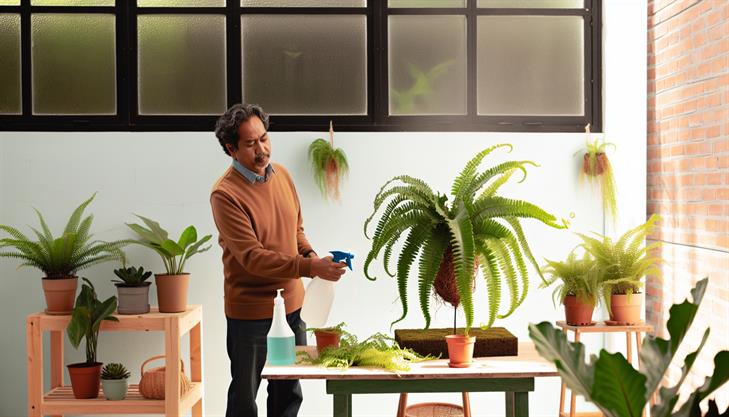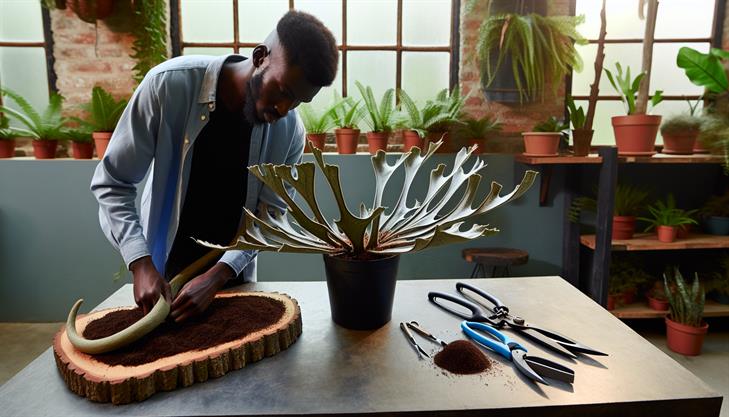Imagine waking up to the sight of a lush, exotic plant adorning your wall, its cascading fronds creating a captivating piece of living art. This isn’t just a dream for plant enthusiasts—it’s the reality of nurturing a thriving staghorn fern. These unique and stunning epiphytes are more than just decorative foliage; they are a testament to the wonder of nature, with their antler-like leaves that can transform any space into a verdant sanctuary. But as with all beauty, it requires a bit of effort. Caring for a staghorn fern comes with its own set of challenges, but with the right knowledge, anyone can master the art of its maintenance.
In a world where houseplants are increasingly popular for their ability to purify air, reduce stress, and enhance home aesthetics, understanding the intricacies of delicate species like the staghorn fern is crucial. Unlike their soil-loving counterparts, these ferns have unique care needs that, when met, can provide years of growth and satisfaction. This guide will equip you with everything you need to not only keep your staghorn fern alive but flourishing. Read on to uncover the secrets to creating the perfect environment for your plant, tips for proper mounting, and essential watering practices that ensure your staghorn fern remains a vibrant and elegant feature in your home. Whether you’re an experienced plant parent or a budding botanist, this guide will help you elevate your indoor gardening game.
Getting Started with Staghorn Fern: A Step-by-Step Guide
Staghorn ferns are unique and captivating epiphytes, which means they naturally grow on other plants rather than in soil. Their dramatic fronds and interesting growth patterns make them popular choices for indoor and outdoor gardens. However, to keep your staghorn fern healthy and thriving, it’s essential to understand and meet their specific care requirements. Here’s a simple step-by-step guide on how to care for your staghorn fern.
-
Mounting Your Staghorn Fern:
- Select a Mount: Staghorn ferns can be mounted on pieces of wood, like cedar or driftwood. You could also use a wire basket filled with sphagnum moss.
- Prepare the Surface: If using wood, soak it in water to prevent it from drawing moisture away from the plant.
- Attach the Fern: Position your fern on the mount, ensuring the basal fronds (the rounded, flat leaves) are secured flat against the surface. Secure the fern using fishing line or soft wire, looping it around the mount and fern several times to hold it firmly.
-
Lighting Requirements:
- Staghorn ferns prefer bright, indirect light. Avoid direct sunlight, as it can scorch their delicate fronds. Ideal locations include east-facing windows or well-lit rooms with filtered sunlight.
-
Watering Techniques:
- Frequency: Water your staghorn fern every 1-2 weeks, depending on the humidity and temperature of your environment. They generally need more water in warmer months.
- Method: Submerge the entire mount in water or thoroughly hose it down. Allow the plant to soak for about 10-20 minutes, ensuring the roots are well hydrated, and then let it drain completely.
-
Humidity and Temperature:
- These ferns thrive in humid environments. Consider misting them regularly or placing a humidifier nearby, especially if you live in a dry climate.
- Keep the temperature between 60-80°F (15-27°C). Staghorn ferns are sensitive to extreme temperatures, so avoid placing them near heaters or air conditioners.
-
Fertilization:
- Fertilize your staghorn fern monthly during the growing season (spring and summer) with a balanced, water-soluble fertilizer diluted to half strength. This helps promote lush growth.
-
Pruning and Maintenance:
- Remove any brown or damaged fronds to allow new growth. Be careful not to remove the basal fronds, as they are essential for the plant’s nutrients and water absorption.
-
Common Issues:
- Yellowing Fronds: This can indicate overwatering. Allow the plant to dry out more between waterings.
- Brown Tips: Often a sign of low humidity. Increase misting or use a humidifier.
- Pests: Watch out for pests like scale or mealybugs. Treat infestations with insecticidal soap or neem oil.
By following these steps, you can ensure your staghorn fern remains a stunning centerpiece in your plant collection. Regular attention to their water, light, and humidity needs will keep these remarkable plants flourishing. As you gain confidence, consider experimenting with different mounting techniques or increasing your indoor plant collection with other epiphytes.
Tips for Optimal Watering and Light Conditions
Caring for a staghorn fern can seem daunting at first, but with the right techniques, these distinctive plants can thrive beautifully in your home or garden. Here, we’ll guide you through the optimal watering and light conditions necessary to keep your staghorn fern healthy and vibrant.
Watering Tips for Staghorn Fern Care:
-
Understanding Hydration Needs:
Staghorn ferns require careful attention to moisture, as they are epiphytic plants, meaning they naturally grow on trees and absorb moisture from the air. It’s crucial to provide a balance—not too dry and not too wet. -
Watering Frequency:
In general, water your staghorn fern once a week. However, this frequency can change depending on your climate and the location of the fern. It’s essential to keep an eye on humidity levels and adjust watering accordingly. -
Watering Techniques:
Use tepid water and soak the root ball until it is thoroughly moist. Avoid leaving the plant sitting in water to prevent root rot. A good practice is to water the plant early in the day to allow excess water to evaporate by evening. -
Humidity Considerations:
If your staghorn fern is indoors, increase humidity by misting it occasionally or placing a humidifier nearby. In dry climates, you might need to mist the plant more frequently to keep it healthy.
Light Conditions for Staghorn Fern:
-
Ideal Location:
Staghorn ferns thrive in bright, indirect light. Think of the dappled sunlight that filters through tree canopies—this is closest to their natural environment. Direct sunlight can scorch the fronds, so avoid placing them in direct sun. -
Indoor Placement:
If you’re growing your staghorn fern indoors, choose a spot near a window where it can receive indirect light. East or west-facing windows are often suitable, but make sure to use sheer curtains to diffuse any harsh sunlight. -
Outdoor Setting:
Outdoors, staghorn ferns do well when mounted on trees or hung in baskets in shaded areas. The natural airflow and ambient light are ideal for promoting healthy growth.
Additional Tips for Maintaining Staghorn Fern Health:
-
Proper Mounting:
For an authentic display, mount the staghorn fern on a wooden board or bark slab, mimicking their natural growth habits. Ensure it’s secure and spaced away from the mount to allow air circulation. -
Feeding:
Fertilize your staghorn fern monthly during the growing season with a balanced, water-soluble fertilizer diluted to half strength. Avoid over-fertilization, as this can damage the plant. -
Common Issues:
Watch for signs of overwatering, such as black spots on fronds, which can indicate root rot. Yellowing fronds may signal insufficient light or nutrient deficiencies. -
Regular Maintenance:
Prune dead or damaged fronds to encourage new growth and maintain a tidy appearance. Check regularly for pests like scales, and treat promptly with as-needed solutions.
By understanding and implementing these strategies, you’ll provide the best environment for your staghorn fern, ensuring it remains a stunning addition to your plant collection. Adjust your care routine based on seasonal changes and plant responses, and you’ll be rewarded with a thriving, lush fern.
Using Fertilizers and Nutrients for Lush Growth
Caring for a staghorn fern involves understanding its unique needs and environment to ensure vibrant and lush growth. Here’s a complete guide to help you care for your staghorn fern effectively.
Understanding Staghorn Ferns:
Staghorn ferns are epiphytic plants, meaning they grow on other plants rather than in soil. They are native to tropical and subtropical regions and are known for their distinctive antler-like fronds.
Optimal Growing Conditions:
-
Light Requirements: Staghorn ferns prefer bright, indirect light. Avoid direct sunlight as it can scorch their leaves. Ideal spots are near east or north-facing windows or where they can receive filtered sunlight.
-
Temperature and Humidity: These ferns thrive in warm conditions, ideally between 60°F to 80°F (15°C to 27°C). They love humidity, so consider placing them in bathrooms or kitchens where moisture levels are naturally higher, or use a humidifier.
Mounting Your Staghorn Fern:
Since they are epiphytes, staghorn ferns do best when mounted on a piece of wood or hung in a basket. Here’s how you can mount them effectively:
- Select a piece of wood or a wooden plaque. Cedar or oak works well due to their resistance to rot.
- Secure a handful of sphagnum moss on the wood.
- Gently attach the fern’s root ball to the moss, ensuring the shield fronds face outward.
- Use fishing line or soft strips of fabric to secure the fern to the mount. Wrap it firmly, but avoid cutting into the plant.
Watering Guidelines:
Water your staghorn fern about once a week or whenever the moss feels dry to the touch. Submerge the entire mount in water for about 10 to 15 minutes, allowing the plant to soak up moisture. Increase watering frequency in warmer months and reduce during cooler months.
Feeding Your Fern:
During the growing season (spring and summer), feed your staghorn fern monthly with a liquid fertilizer diluted to half strength. Use fertilizers high in nitrogen to promote leaf growth. Avoid over-fertilizing, as this can harm your plant.
Common Issues and Solutions:
- Brown Spots on Fronds: This could indicate too much direct sunlight or insufficient humidity. Move the plant to a shadier spot and increase humidity.
- Yellowing Fronds: Overwatering can lead to root rot, causing leaves to yellow. Ensure your fern has adequate air circulation and reduce watering.
- Slow Growth: Lack of nutrients might be the issue. Ensure you’re regularly feeding your fern during its growth period.
Additional Care Tips:
- Regularly mist your fern to enhance humidity, especially if located in a dry climate.
- Periodically rotate your plant to ensure even growth.
- Keep an eye on new fronds. Healthy growth is a good indicator that your care routine is effective.
By following these guidelines on how to care for your staghorn fern, you’ll enjoy a flourishing plant that adds a unique touch to your indoor garden. Remember, each fern may have slightly different needs based on its environment, so adjust care routines as necessary.
Pruning and Potting Techniques for Healthy Ferns
Caring for a staghorn fern involves understanding its unique needs and environmental preferences. These stunning plants, known for their antler-like fronds, thrive when cared for with attention to humidity, watering, and proper mounting techniques. Here’s a comprehensive guide on how to care for staghorn fern, ensuring it remains healthy and vibrant in your home or garden.
Mounting and Potting Techniques
-
Selecting the Right Mount: Staghorn ferns are epiphytes, meaning they naturally grow on trees. Ideally, mount them on a wooden board or bark slab. Use organic materials like sphagnum moss to provide a natural cushion that retains moisture.
-
Creating the Mount: First, soak the sphagnum moss in water for a few hours. Once it’s moist, make a mound on the mount’s surface. Place the fern on top of this mound, ensuring its roots are in contact with the moss. Secure the plant with fishing line or wire, wrapping it around the mount and the fern securely without damaging the plant.
-
Potting Option: If mounting isn’t feasible, staghorn ferns can also be potted. Use a loose, well-draining potting mix, such as one made for orchids or a blend of peat moss and bark. Place the fern in a shallow pot as they don’t require deep root space.
Watering and Humidity
-
Consistent Moisture: Staghorn ferns prefer to be consistently moist but not waterlogged. Water your fern by soaking the mount or pot thoroughly. During warmer months, you may need to water more frequently, approximately once a week. In cooler months, reduce watering to every 10-14 days.
-
Humidity Needs: High humidity is crucial for these ferns. If you live in a dry climate, consider misting the plant regularly or using a humidifier. Grouping plants together can help create a micro-climate that increases surrounding humidity.
Light and Temperature
-
Light Requirements: Staghorn ferns thrive in bright, indirect light. Direct sunlight can scorch the leaves, so place them in a location with filtered light, such as near a north or east-facing window.
-
Temperature: These ferns prefer temperatures between 60°F and 80°F (15°C to 27°C). Keep them away from cold drafts or heating vents which can cause stress.
Pruning and Maintenance
-
Pruning Tips: Regularly remove any dead or damaged fronds to encourage healthy growth. Use clean, sharp scissors or pruning shears to prevent the spread of disease.
-
Feeding: Fertilize staghorn ferns monthly during the growing season (spring and summer) using a balanced, water-soluble fertilizer diluted to half-strength.
Common Issues and Solutions
-
Brown Tips: Often a sign of low humidity or underwatering. Increase humidity around the plant and adjust watering as necessary.
-
Yellowing Fronds: Overwatering or poor drainage can lead to yellowing. Ensure the mounting medium or potting mix allows adequate drainage and reduce watering frequency.
-
Pests: Keep an eye out for pests like scale or mealybugs. Regularly wipe fronds with a damp cloth and use an insecticidal soap if necessary.
By following these care guidelines, you can maintain a thriving staghorn fern, adding a unique and natural aesthetic to your living space. With the right attention to detail, these remarkable plants can flourish indoors or mounted in a garden setting.
Troubleshooting Common Problems and Solutions
Caring for a staghorn fern can be a delightful experience, as these unique plants add a touch of greenery with their distinct antler-like leaves. Whether you are a seasoned plant enthusiast or a beginner, understanding the specific needs of staghorn ferns is crucial for their healthy growth. Below, you will find a comprehensive guide on how to care for a staghorn fern, including troubleshooting common problems, setup tips, and more.
Understanding Staghorn Ferns
Staghorn ferns belong to the Platycerium genus and are epiphytic, meaning they naturally grow on trees and absorb nutrients from the air. Recognizing their natural habitat helps in replicating their preferred conditions at home.
Light Requirements
Staghorn ferns thrive in bright, indirect light. Direct sunlight can harm the plant, causing the leaves to burn. If you’re growing your fern indoors, place it near a window where it can receive filtered light. Outdoors, positioning it under a tree or a shaded porch is ideal.
Watering Techniques
Proper watering is crucial when learning how to care for staghorn fern. Typically, they need watering once a week. However, the frequency can vary based on humidity and temperature. Use a method where you thoroughly soak the fern, allowing water to drain completely. Ensure the plant dries out between waterings to prevent root rot, a common issue with staghorn ferns.
Mounting and Potting
Mounting a staghorn fern mimics its natural growth on trees, providing both support and aesthetic appeal. To mount a fern:
- Choose a Suitable Board: Use a wooden board or a piece of cork bark as a base.
- Create a Bed of Moss: Place sphagnum moss on the center of the board for added moisture retention.
- Position the Fern: Secure the fern over the moss, using fishing line or nylon string to attach it. Ensure the basal fronds are flush with the board.
For potting, use a well-draining medium. Applying the potting option is less common but can be effective if done right.
Feeding Your Staghorn
Fertilizing is key to staghorn fern care. Use a balanced, water-soluble fertilizer diluted to half-strength during the growing season (spring and summer). Fertilizing once a month is generally sufficient.
Handling Common Issues
-
Brown Tips and Edges: This is often a sign of under-watering or low humidity. Increase humidity by misting the plant or placing it near a humidifier.
-
Leaf Drop or Yellowing: These symptoms might indicate overwatering. Adjust your watering schedule and ensure proper drainage.
-
Pests: Pests like scale and mealybugs can be a problem. Remove them by gently wiping the leaves with a soft cloth dipped in soapy water or use an appropriate insecticidal spray if necessary.
Environmental Conditions
Replicate a tropical environment by maintaining a humidity level of around 60-80%. This can be achieved by grouping plants together or using pebble trays filled with water. Avoid placing the fern near air conditioners or heaters, as these can lead to rapid moisture loss.
Pruning and Maintenance
Trim away any dead or damaged fronds to promote healthy growth. While doing so, be careful not to damage the shield fronds, which are vital for the plant’s growth and nutrient absorption.
By following these steps and monitoring your plant’s environment, you can ensure that your staghorn fern remains healthy and vibrant. Regularly assessing your fern’s condition and being attentive to changes will allow you to address any issues promptly, making staghorn fern care a rewarding endeavor.
In conclusion, caring for a staghorn fern involves understanding its unique needs and providing an environment that mimics its natural habitat. Key points to remember include mounting your fern in a location that offers bright, indirect light and ensuring adequate humidity and air circulation. Regular watering is crucial, but it’s equally important to allow the fern to dry out between waterings to prevent root rot. Feeding it with a balanced fertilizer every few months will promote healthy growth.
By implementing these care techniques, you’ll be well-equipped to keep your staghorn fern thriving and vibrant. Don’t be afraid to experiment with different mounting and watering techniques to see what works best for your plant.
As a final tip, consider rotating your fern occasionally to ensure even light exposure, which can encourage symmetrical growth and a more aesthetically pleasing appearance. With consistent care and attention, your staghorn fern will become a striking and eye-catching addition to your plant collection.


